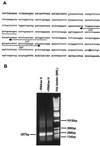A splice site mutant of maize activates cryptic splice sites, elicits intron inclusion and exon exclusion, and permits branch point elucidation
- PMID: 10517832
- PMCID: PMC59403
- DOI: 10.1104/pp.121.2.411
A splice site mutant of maize activates cryptic splice sites, elicits intron inclusion and exon exclusion, and permits branch point elucidation
Abstract
DNA sequence analysis of the bt2-7503 mutant allele of the maize brittle-2 gene revealed a point mutation in the 5' terminal sequence of intron 3 changing GT to AT. This lesion completely abolishes use of this splice site, activates two cryptic splice sites, and alters the splicing pattern from extant splice sites. One activated donor site, located nine nt 5' to the normal splice donor site, begins with the dinucleotide GC. While non-consensus, this sequence still permits both trans-esterification reactions of pre-mRNA splicing. A second cryptic site located 23 nt 5' to the normal splice site and beginning with GA, undergoes the first trans-esterification reaction leading to lariat formation, but lacks the ability to participate in the second reaction. Accumulation of this splicing intermediate and use of an innovative reverse transcriptase-polymerase chain reaction technique (J. Vogel, R.H. Wolfgang, T. Borner [1997] Nucleic Acids Res 25: 2030-2031) led to the identification of 3' intron sequences needed for lariat formation. In most splicing reactions, neither cryptic site is recognized. Most mature transcripts include intron 3, while the second most frequent class lacks exon 3. Traditionally, the former class of transcripts is taken as evidence for the intron definition of splicing, while the latter class has given credence to the exon definition of splicing.
Figures




Similar articles
-
A combinatorial role for exon, intron and splice site sequences in splicing in maize.Plant J. 1997 Jun;11(6):1253-63. doi: 10.1046/j.1365-313x.1997.11061253.x. Plant J. 1997. PMID: 9225466
-
Cryptic intron activation within the large exon of the mouse polymeric immunoglobulin receptor gene: cryptic splice sites correspond to protein domain boundaries.Nucleic Acids Res. 1999 Sep 1;27(17):3446-54. doi: 10.1093/nar/27.17.3446. Nucleic Acids Res. 1999. PMID: 10446232 Free PMC article.
-
A novel single-base substitution (380C>T) that activates a 5-base downstream cryptic splice-acceptor site within exon 5 in almost all transcripts in the human mitochondrial acetoacetyl-CoA thiolase gene.Mol Genet Metab. 2001 Feb;72(2):115-21. doi: 10.1006/mgme.2000.3125. Mol Genet Metab. 2001. PMID: 11161837
-
Mutations that alter RNA splicing of the human HPRT gene: a review of the spectrum.Mutat Res. 1998 Nov;411(3):179-214. doi: 10.1016/s1383-5742(98)00013-1. Mutat Res. 1998. PMID: 9804951 Review.
-
The Importance of a Genome-Wide Association Analysis in the Study of Alternative Splicing Mutations in Plants with a Special Focus on Maize.Int J Mol Sci. 2022 Apr 11;23(8):4201. doi: 10.3390/ijms23084201. Int J Mol Sci. 2022. PMID: 35457019 Free PMC article. Review.
Cited by
-
Simultaneous CRISPR/Cas9-mediated editing of cassava eIF4E isoforms nCBP-1 and nCBP-2 reduces cassava brown streak disease symptom severity and incidence.Plant Biotechnol J. 2019 Feb;17(2):421-434. doi: 10.1111/pbi.12987. Epub 2018 Oct 5. Plant Biotechnol J. 2019. PMID: 30019807 Free PMC article.
-
Retrotransposons of the Tnt1B family are mobile in Nicotiana plumbaginifolia and can induce alternative splicing of the host gene upon insertion.Plant Mol Biol. 2001 Nov;47(4):533-41. doi: 10.1023/a:1011846910918. Plant Mol Biol. 2001. PMID: 11669578
-
A single-base substitution suppresses flower color mutation caused by a novel miniature inverted-repeat transposable element in gentian.Mol Genet Genomics. 2011 Dec;286(5-6):371-82. doi: 10.1007/s00438-011-0652-x. Epub 2011 Oct 15. Mol Genet Genomics. 2011. PMID: 22002873
-
Ty3/gypsy-like retrotransposon knockout of a 2-methyl-6-phytyl-1,4-benzoquinone methyltransferase is non-lethal, uncovers a cryptic paralogous mutation, and produces novel tocopherol (vitamin E) profiles in sunflower.Theor Appl Genet. 2006 Sep;113(5):783-99. doi: 10.1007/s00122-006-0321-3. Epub 2006 Aug 9. Theor Appl Genet. 2006. PMID: 16902787
-
Three non-allelic epistatically interacting methyltransferase mutations produce novel tocopherol (vitamin E) profiles in sunflower.Theor Appl Genet. 2006 Sep;113(5):767-82. doi: 10.1007/s00122-006-0320-4. Epub 2006 Aug 4. Theor Appl Genet. 2006. PMID: 16896719
References
-
- Aebi M, Hornig H, Padgett RA, Reiser J, Weissmann C. Sequence requirements for splicing of higher eucaryotic nuclear pre-mRNA. Cell. 1986;47:555–565. - PubMed
-
- Antoniou M. Clinical defects in pre-mRNA processing. In: Lamond AI, editor. Pre-mRNA Processing. Austin, TX: RG Landes; 1995. pp. 187–201.
-
- Bae JM, Giroux M, Hannah LC. Cloning and characterization of the Brittle-2 gene of maize. Maydica. 1990;35:317–322.
-
- Barta A, Sommergruber K, Thompson D, Harmuth K, Matzke ME, Matzke AJM. The expression of Nopaline synthase-human growth hormone chimaeric gene in transformed tobacco and sunflower callus tissue. Plant Mol Biol. 1986;6:347–357. - PubMed
-
- Berget SM. Exon recognition in vertebrate splicing. J Biol Chem. 1995;270:2411–2414. - PubMed
Publication types
MeSH terms
Substances
LinkOut - more resources
Full Text Sources
Other Literature Sources
Research Materials
Miscellaneous

